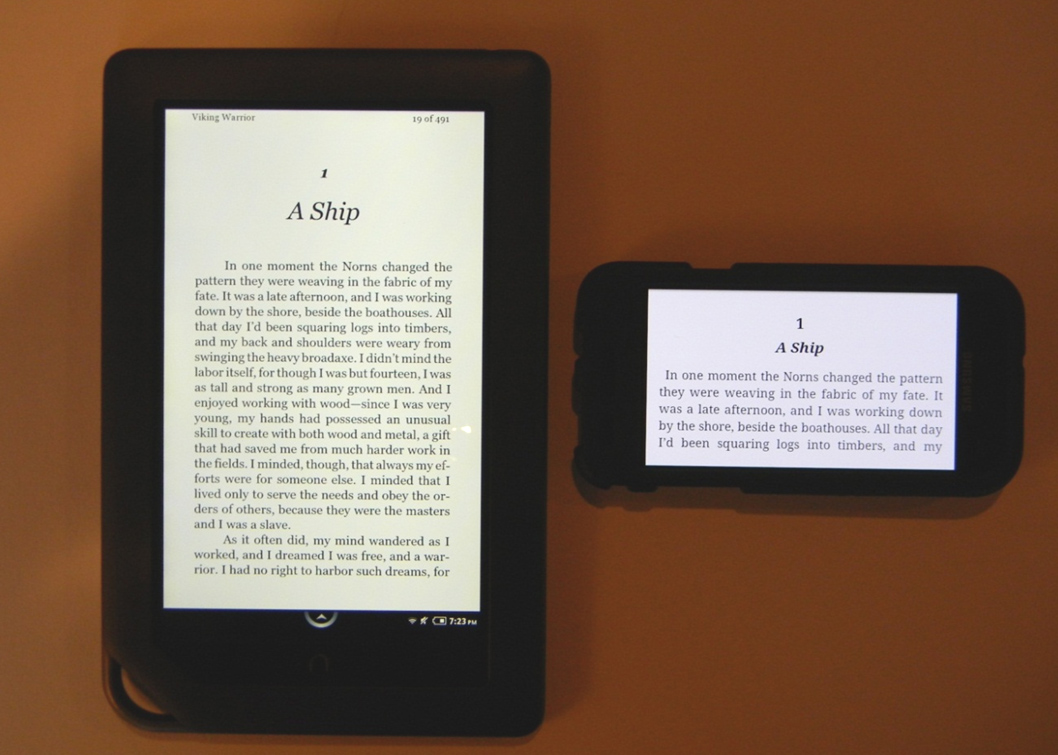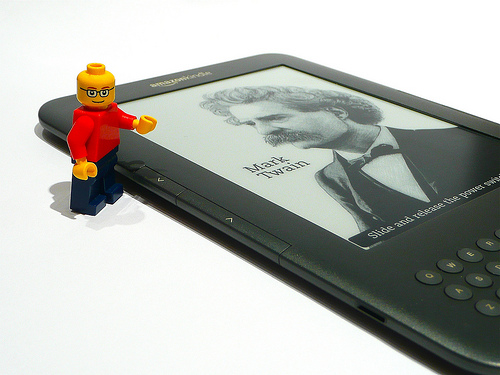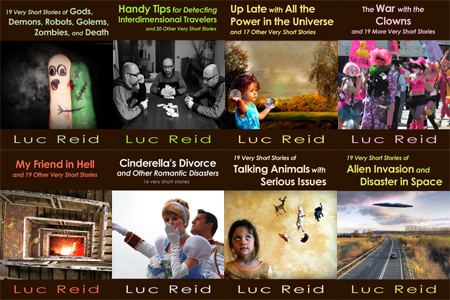Here’s a guest post from Judson Roberts, author of the Strongbow Saga trilogy of Viking novels. Jud had given his assessments of these two eReaders in an e-mail discussion, and on my request kindly agreed to put his observations into a blog post.
You can see a larger version of any image by clicking on it.
Two years ago, digital books, or e-books, were something that relatively few people had any personal experience with. Although e-books had actually been around for a number of years, they’d never really caught on. But in mid-2010, that changed. In the months leading up to Christmas, Amazon significantly reduced the price of its Kindle e-book reader. Sales of the device took off, and in January, when millions of new Kindles became activated, the rate of e-book sales exploded. It has been growing ever since.
E-books can be read on a wide variety of devices, including personal computers, tablet computers, smartphones, and dedicated e-book readers. But the tremendous growth in e-book sales that has occurred in the United States (the rate of e-book sales in overseas markets has not yet seen the same level of dramatic growth) has been, to a large extent, driven by repeated price reductions over the past year of the two most popular and widely used dedicated e-book readers: the Amazon Kindle and the Barnes & Noble Nook, particularly the top of the line Color Nook. In this column, I will offer my personal opinion and experiences with both devices (Why, you might wonder, would I own both devices? I’m an author and have published some of my books as e-books, so I use both devices in part to review my e-book editions prior to releasing them.).
First, their similarities. Neither device is intended by its parent company to be an open source e-reader. By that, I mean that each device is tied to its parent company’s store, and designed to most easily access e-books sold through that store. Unless the user is willing to undertake some work-around steps (which admittedly are not that difficult to do, and which I’ll address in more detail below), a Kindle can easily load and read only Kindle e-books purchased from Amazon; a Nook only Nook books purchased from Barnes & Noble. The actual process of purchasing an e-book is fairly similar for both devices: either on a computer, or directly from the device, you access the parent company’s website, select a book, purchase it (for the devices to be activated when purchased, both require an active account with the parent company), and the book will be sent to your device.
In addition to the parent company’s e-books, it is possible to load documents in various formats, including Microsoft Word and Adobe PDF, onto both devices. The Nook also accepts EPUB files, the mostly widely used e-book format (which Nook e-books are in), and the newer Kindles accept Mobi format files, another e-book format. Thus, if a user acquires or already possesses e-books in the PDF format, they can be manually loaded on either the Kindle or the Nook. Additionally, non-B&N EPUB e-books can be manually loaded onto the Nook, and non-Amazon Mobi format e-books can be manually loaded onto the Kindle. For the present, at least, Kindle readers do not accept EPUB files or books, and Nook Color readers do not accept Mobi files or e-books, or Amazon’s proprietary Kindle format (which is derived from the Mobi format).
Documents and non-Nook e-books are loaded onto the Nook by connecting it via a USB cable (supplied with the device) to a personal computer, and transferring or copying them from the computer to the Nook. Documents and non-Kindle e-books may be loaded onto a Kindle using the same procedure, but Amazon also offers a far easier procedure: each Kindle is assigned an email address, and some formats of documents can simply be attached to an email sent to that address, after which they will appear on the device within minutes. [Luc adds: there’s a free way to do this if you’re willing to receive your documents or eBooks through WiFi only and not through Amazon’s cellular Whispernet by sending it to a @free.kindle.com address: see your Kindle documentation for details. Also note that purchases from Amazon for the Kindle are automatically downloaded to the device.]
The Nook is WiFi only, which means that it cannot connect to the B&N website and acquire and load new books unless it is connected to a WiFi network. The Kindle is available in two different connectivity options: WiFi only, or an always-available connection via 3G cell phone networks. The latter does not require any additional charge or plan for network access and use, but the 3G versions of the Kindle device are more expensive than the WiFi only versions. Both devices, when connected, offer some degree of web browsing capability.
The two devices differ most markedly in how they operate. The Color Nook is a touchscreen device that looks much like a tablet-style computer, and runs on a version of Google’s popular Android operating system, which is widely used in non-Apple smartphones and tablet computers. Indeed, Barnes & Noble has even advertised the Color Nook as the least expensive Android tablet available. That is a dangerous claim to make, although not because of the price. Compared to other Android devices, the Color Nook is either extremely underpowered or its capabilities have been grossly limited by Barnes & Noble’s restrictive control over the device.
![]()

The B&N Color Nook versus the free Amazon Kindle app on a smartphone
The Nook versus smartphone comparison raises another flaw with the Nook. One of the great things about smartphones is the numerous apps you can load and use on them. Their variety and functions are almost endless, and there are countless Android based apps available. As an Android device, the Nook should be able to use them, too. But no—Barnes & Noble does allow a few apps, sold through their store, to be installed and used on the Nook, but the selection is limited and is strictly controlled by B&N, in their own inimitable style. For example, Epicurious is an excellent cooking website with numerous recipes that are well organized, easy to search, and are even rated by users. There is a free Epicurious app available for Android smartphones—my wife loves it, and uses it all the time. Barnes & Noble now offers the Epicurious app through their store for the Color Nook, too—but they charge $5.99 for an app that is available free for other Android devices.
The actual Kindle e-book reader is a completely different kind of device than a touchscreen Nook or smartphone. It is controlled entirely by a manual keyboard below the screen and by various manual buttons, all of which are clearly labeled as to what function they perform. While the result may not present as sleek and elegant an appearance as the Color Nook, it works well and is easy to use. If I want to access the menu, I simply press the button labeled “Menu,” then navigate the options than appear onscreen using the multi-directional navigation and select button. If I want to go to the home page, where all books currently loaded on the device are listed and accessible (and from where I can access other Kindle books I’ve purchased, but which are not currently loaded on the device), I press the “Home” button. If I wish to advance to the next page, or go back to the previous one, I press the forward or back buttons located on both sides of the device. The Kindle is like a good tool whose design is based on considerations of function first, and appearance second. I liken it to a hammer that so perfectly fits your hand and is so well balanced that you strike true with it every time. It’s a personal preference, but give me function over flash.
![]() Kindle
Kindle and
Nook e-book versions, as well as in
print editions).
Like this:
Like Loading...

Apr 14, 2011
Judson Roberts is a former organized crime prosecutor and current full-time writer living in Texas. His series of historical novels set among the Vikings, The Strongbow Saga, was originally published by HarperCollins and is now finding even greater success published through Roberts’ own Northman Books. This Codex Blog Tour interview follows up on an earlier interview about the writing of the books, following the Saga‘s sometimes difficult path through the publishing world and out the other side to readers. It will be followed by part II this weekend.
I gather there were some publishing problems with the original editions of your Strongbow Saga books, including things like the publisher not sending out any review copies (a major concern!), the covers seeming to suggest a romance rather than a historical adventure, the publisher not picking up the fourth and fifth books, and other issues. Despite these kinds of problems, though, for a long time traditional publishers have been pretty much the only game in town. So what made you feel it was worth putting your full efforts into republishing the books yourself?
Unfortunately your relatively simple question does not have a correspondingly short and simple answer. Let me explain.

Mar 7, 2011
My Flash Fiction book, Bam! 172 Hellaciously Quick Stories is available for eReaders on Smashwords and Amazon.com. This week only, as part of a promotion for Read an eBook Week, Bam! is available on Smashwords for 100% off, also known as “free.” Use the coupon code RE100. No strings attached, but if you like the book, I wouldn’t mind if you talked it up a little.
Repost this if you’d like; it will be over in just seven short days.
LATER EDIT: The week is now over, and the offer proved very successful. Thanks for your interest in the book.
Like this:
Like Loading...

Feb 3, 2011

In a discussion of eBooks on Codex, an online writer’s group I started seven years ago, the subject came up of market saturation: with more and more eBooks hitting the market as the readership expands, will there come a time when there are too many books out there for many of them to make more than a little money? In response to that question, here are some predictions about the eBook market over the next decade, based on thinking about social and technological trends.
One reason I’m as interested as I am in this topic that I have friends on Codex who are beginning to see real success (measured in hundreds or thousands of dollars) through eBook publishing, primarily for the Kindle, especially Judson Roberts with his compelling and exceptionally well-researched series of Viking novels and James Maxey with his inventive and emotionally complex novels about dragons, dragon hunters, and superheroes. (See also Jud’s Web site at judsonroberts.com and James’ at jamesmaxey.blogspot.com.) Also fascinating is the POD success of Maya Lassiter with her free audiobook, Conjuring Raine, which to date has been downloaded more than 2,000 times.
Many more eBooks coming
I don’t think we’ve seen anything yet in terms of number of eBooks available: people who are putting out eBooks now are still early adopters, but before long publishers will be putting out every last book they have rights to, many more writers will take books out of the submission cycle of traditional publishing and try to get some juice out of the eBook market instead, and the majority of authors (and authors’ estates) who have rights to their backlists will make those books available as eBooks too. Why leave money on the table, after all? Most things that have gone out of print ever will reappear, along with many things that were written over the past few decades but never made it into print, making the field much more crowded.
By the way, I’m suspecting there will be at least a few amazing finds among books that have been lost in slush–along with lots and lots and lots of garbage.
Many more readers coming, and not just the ones we already write for
At the same time, over the coming decade the market for English language eBooks will continue to expand, not only as eReaders are adopted by an ever-increasing percentage of the public in English-speaking countries, but as eReaders and smartphones reach more and more of the world’s population. In the past almost all English-language writers have been writing mainly for native English speakers. As China and India and the Middle East and the rest of the world adopt eReaders, barriers to books from here reaching English speakers in other countries will fall. How many of your books are available in India, for instance, a country that has very nearly as many English-speakers as the United States? Or Nigeria, where English-speakers number almost 80 million? Or even in Australia, for that matter?
Further, as English language materials become more widely available, and as communication across national boundaries continues to expand, especially over the Web, many more people will learn English than have in the past. If you live in Mongolia, for instance, ten years ago English would have been of little use to you. Today if you know English and have any kind of Internet access, you have access to the largest single-language collection of information and entertainment ever in the history of humankind.
So even though there’s going to be more competition, I think it’s still going to be boom time for English language writers for the next decade or so, and with the continued spread of English, some growth for another decade or two after that, and possibly even longer.
This growth in number of readers will not be matched by writers from those same areas. If you speak English well, you can be a reader of English-language books–but to write a good book in English, you have to speak the language like a native, which most readers from non-English-speaking countries don’t. Writers who write in English are likely to benefit from all of this at the expense of writers who work in other languages.
More readers means yet more eBooks
This in turn will lure more people to writing as more and more writers begin making a living through self-published eBook sales. Writing has always been alluring to a lot of people, but most would-be writers are scared off or beaten down by the process of repeated rejections, or else stuck in a decades-long pattern of submit-and-be-rejected. Lifting the barriers means not only removes practical obstacles to getting published, but also emotional obstacles. No longer will you have to be the kind of person who persists in the face of depressingly horrible odds to get your work out. (It could be argued that self-publishing has been an option for a long time, but I’d argue back that getting someone to print your books isn’t the same as having the opportunity to actually get them in front of readers.)
With an influx of less experienced writers who don’t have to get past editorial obstacles, there will be a lot more bad writing available. This, together with the increased use of eReaders and the overall rise in number of eBooks, will create a powerful push for better eBook finding and selection tools for the Web, eReaders, and smart phones. Exactly how these systems will work is a crucial question for writers, because it will determine whether or not our works can be found, the context in which they’ll be considered or compared, and ultimately how well they’ll sell.
In a near-future post I’ll make some predictions about how people will be finding and choosing eBooks, and about what that will mean for writers.
Photo taken in London by DG Jones
Like this:
Like Loading...






